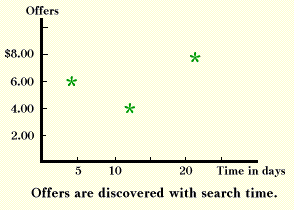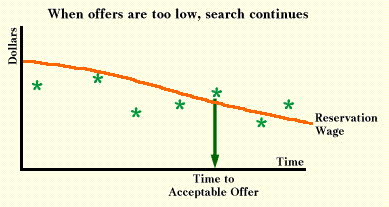Theories of Search
When unemployment rates in the United States drop below 5%, many economists say that the country has reached full employment. But how can this be when there are still millions of people who are still looking for work?
The reason economists seem unconcerned with these millions of people is that they understand that information is not free but can only be obtained with time and effort. As a result, there will always be some level of frictional unemployment. In the graph below, which shows search time on the horizontal axis and wage offers on the vertical, a person finds a job offer of $6.00 on the fourth day of search, an offer of $4.00 on the 12th day, and a third offer of $8.00 on the 21st day. In a world of perfect information, all three offers would be known at time zero so no search would be necessary. The job applicant would simply pick the job that paid the most. When information is not free, deciding which job to pick is more difficult, and we turn to two models for help. The first of these models is a simplified way of describing actual behavior, and the second is useful as a way of seeing optimal behavior.

The first model uses these four assumptions: (a) the searcher has a minimum price (aspiration level or reservation price) that he will accept; (b) the prices offered follow a fixed but unknown probability function; (c) when an offer is made, it must either be accepted or rejected; and (d) the costs of searching and the wages sacrificed by continued search (that is, the searcher could earn money if he accepted a job offer and stopped searching) make the minimum acceptable price decline with time. This model is illustrated below.

Because the searcher does not know the market, he may initially set his aspiration level high to protect himself from taking too poor an offer. With time he reduces this level because of assumption (d) (and also because he knows the market better). Eventually he meets an offer above his aspiration level, and a sale is made.
Thus a person who has been receiving $15.00 per hour and who has been laid off or quit usually sets out to find another job with similar pay and difficulty. If he finds one quickly, he takes it. But if the first offer is a job paying only $10.00, he may reject the offer in hopes of finding something better. Only after he has searched for some time without finding a job for $15.00 will he decide that it is unlikely he will find what he wants and will accept the $10.00 job.
The process described in this model is a good description of how people actually behave, but it does not tell us that there is an optimal or best amount of search time. The idea that there is some optimal amount of search time (which means there is an optimal amount of unemployment) follows directly from the costs and benefits of search, and is an application of the maximization principle on which much microeconomic theory is based. It is a more abstract way of looking at search than our first model.
Suppose Jane Doe enters the labor force with limited knowledge of what jobs are available and begins searching for offers. After some time and effort, she finds a job offer. Should Jane take the job she has found? It all depends on the costs and benefits of searching further. If the costs of additional search are greater than the benefits, she should take the job she has found. If the benefits of additional search are greater than the costs, she should reject the job and continue searching. Unfortunately Jane cannot be sure what the benefits of additional search will be, and her guess may be quite wrong. If she continues to search, she has guessed that extra benefits outweigh the costs. If she takes the job, she has guessed that the extra costs outweigh the extra benefits.
What are the benefits and costs of additional search? The main extra cost is foregone wages of not taking the job that was offered. Thus, if one has found a job opening paying $350.00 per week and one rejects it to search for another four weeks, the cost of the search is $1400.00 plus any additional costs—telephone bills, gasoline, mailing costs—associated with trying to find job openings. Extra benefits exist only if one can find a job opening that pays more than the best existing offer. (We are ignoring non-monetary aspects of jobs that can be as important as wages, aspects such as the pleasantness of the job, its status, and the people one must work for and with.) After an extra month of search, one might find a job paying $360.00 a week. One must compute the extra benefit of this ten dollars a week with the aid of present value tables to learn if the extra month of search was worthwhile.
The graph below illustrates the ideas in this second model. The costs of additional search increase with time because as time goes on one should find higher and higher offers. The cost of extra search is the wages one could have had if one took the highest wage offered. The benefits of extra search should diminish because after some search it becomes harder and harder to find better offers. The optimum level of search occurs at the intersection of the marginal cost and marginal benefit curve.

This model implies that there is an optimum amount of time to remain unemployed. If this sounds strange, it is probably because you are comparing the world to an ideal with perfect information. In a world of perfect information, the optimum search time would be zero. But when information must be acquired through time and effort, searching for employment is a productive activity, not a waste. Search produces information so that better decisions can be made. It is this realization that has made economists relatively unconcerned with "reasonable" levels of unemployment (though many would like to find ways to make information easier to obtain and thus make search both more productive and shorter). Note, however, that the model implies only that there is an optimum search time, and not that any searcher will know what it is.
The theories of search were developed to make sense of the Phillips Curve.
   
Copyright Robert Schenk
|